
The Percidae are a family of ray-finned fish, part of the order Perciformes, which are found in fresh and brackish waters of the Northern Hemisphere. The majority are Nearctic, but there are also Palearctic species. The family contains more than 200 species in 11 genera. The perches and their relatives are in this family; well-known species include the walleye, sauger, ruffe, and three species of perch. However, small fish known as darters are also a part of this family.
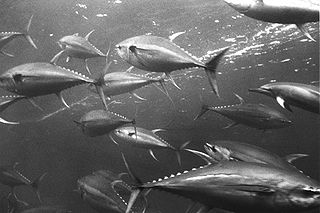
The mackerel, tuna, and bonito family, Scombridae, includes many of the most important and familiar food fishes. The family consists of 51 species in 15 genera and two subfamilies. All species are in the subfamily Scombrinae, except the butterfly kingfish, which is the sole member of subfamily Gasterochismatinae.

The Cottidae are a family of fish in the superfamily Cottoidea, the sculpins. It is the largest sculpin family, with about 275 species in 70 genera. They are referred to simply as cottids to avoid confusion with sculpins of other families.
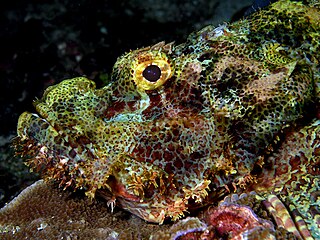
The Scorpaenidae are a family of mostly marine fish that includes many of the world's most venomous species. As their name suggests, scorpionfish have a type of "sting" in the form of sharp spines coated with venomous mucus. The family is a large one, with hundreds of members. They are widespread in tropical and temperate seas but mostly found in the Indo-Pacific. They should not be confused with the cabezones, of the genus Scorpaenichthys, which belong to a separate, though related, family, Cottidae.
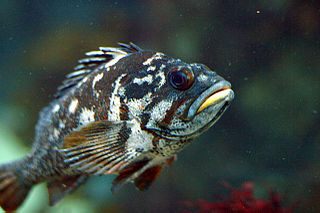
Sebastinae is a subfamily of marine fish belonging to the family Scorpaenidae in the order Scorpaeniformes. Their common names include rockfishes, rock perches, ocean perches, sea perches, thornyheads, scorpionfishes, sea ruffes and rockcods. Despite the latter name, they are not closely related to the cods in the genus Gadus, nor the rock cod, Lotella rhacina.

The Carangidae are a family of ray-finned fish that includes the jacks, pompanos, jack mackerels, runners, trevallies, and scads. It is the largest of the six families included within the order Carangiformes. Some authorities classify it as the only family within that order but molecular and anatomical studies indicate that there is a close relationship between this family and the five former Perciform families which make up the Carangiformes.
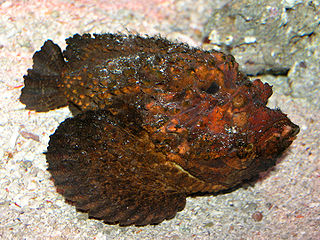
Synanceiinae is a subfamily of venomous ray-finned fishes, waspfishes, which is classified as part of the family Scorpaenidae, the scorpionfishes and their relatives. These fishes are found in the Indo-Pacific oceans. They are primarily marine, though some species are known to live in fresh or brackish waters. The various species of this family are known informally as stonefish, stinger, stingfish and ghouls. Its species are known to have the most potent neurotoxins of all the fish venoms, secreted from glands at the base of their needle-like dorsal fin spines. The vernacular name, stonefish, for some of these fishes derives from their behaviour of camouflaging as rocks. The type species of the family is the estuarine stonefish.

Hexagrammidae, the greenlings, is a family of marine ray-finned fishes belonging to the suborder Cottoidei in the order Scorpaeniformes. These fishes are found in the North Pacific Ocean.

The Pacific staghorn sculpin is a species of marine ray-finned fish belonging to the family Cottidae, the typical sculpins. This species is found in the eastern Pacific Ocean. It is the only species in the monospecific genus Lepidocottus.

The Gobionellinae are a subfamily of fish which was formerly classified in the family Gobiidae, the gobies, but the 5th Edition of Fishes of the World classifies the subfamily as part of the family Oxudercidae. Members of Gobionellinae mostly inhabit estuarine and freshwater habitats; the main exception is the genus Gnatholepis, which live with corals in marine environments. The subfamily is distributed in tropical and temperate regions around the world with the exception of the northeastern Atlantic Ocean, the Mediterranean Sea, and the Ponto-Caspian region. It includes around 370 species and 55 genera: Wikipedia articles about genera list about 389 species.

Clinocottus is a genus of marine ray-finned fishes belonging to the family Cottidae, the typical sculpins. They are nearshore benthic fishes native to the northeastern Pacific Ocean. They are mentioned as sharpnose sculpins.
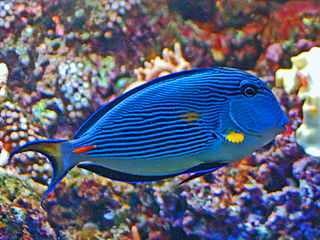
Acanthurinae is a subfamily of marine ray-finned fishes belonging to the family Acanthuridae, found in the Indo-Pacific and the tropical Atlantic. These fishes commonly have the English names surgeonfishes or tangs.

Artedius is a genus of marine ray-finned fishes belonging to the family Cottidae, the typical sculpins. These fishes are found in the northern Pacific Ocean.

Enophrys is a genus of marine ray-finned fishes belonging to the family Cottidae, the typical sculpins. These fishes are found in the northern and eastern Pacific Ocean.

Icelinusis a genus of marine ray-finned fishes belonging to the family Cottidae, the typical sculpins. These fishes are found in the northern and eastern Pacific Ocean.
The lavender sculpin is a species of marine ray-finned fish belonging to the family Cottidae, the typical sculpins. It is found in the eastern Pacific Ocean.
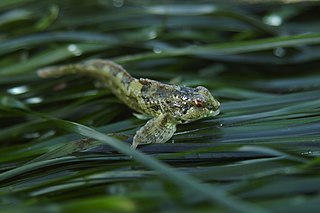
Oligocottus is a genus of marine ray-finned fishes belonging to the family Cottidae, the typical sculpins. These sculpins are found in the northern and eastern Pacific Ocean.

Sebastiscus is a genus of marine ray-finned fish belonging to the subfamily Sebastinae part of the family Scorpaenidae. These fishes are native to the western Pacific Ocean. They are collectively called sea ruffes and resemble the rockfishes in the genus Sebastes, but are usually smaller and have a different pattern.

Haemulinae is a subfamily of the Haemulidae and consists of the genera of that family which are regarded as being of New World origin, although they are now widespread. The subfamily is distinguished from the Plectorhynchinae by having a short dorsal fin which contains 13-16 soft rays, as opposed to the long dorsal fin with 17-26 soft rays of the subfamily Plectorhynchinae.
Menidiinae is a subfamily of the Neotropical silversides, part of the family Atherinopsidae. This subfamily is made up of two tribes, seven genera and around 80 species. They are primarily a tropical subfamily but there are some temperate species, this subfamily is found in both the Atlantic and Pacific Oceans.


















